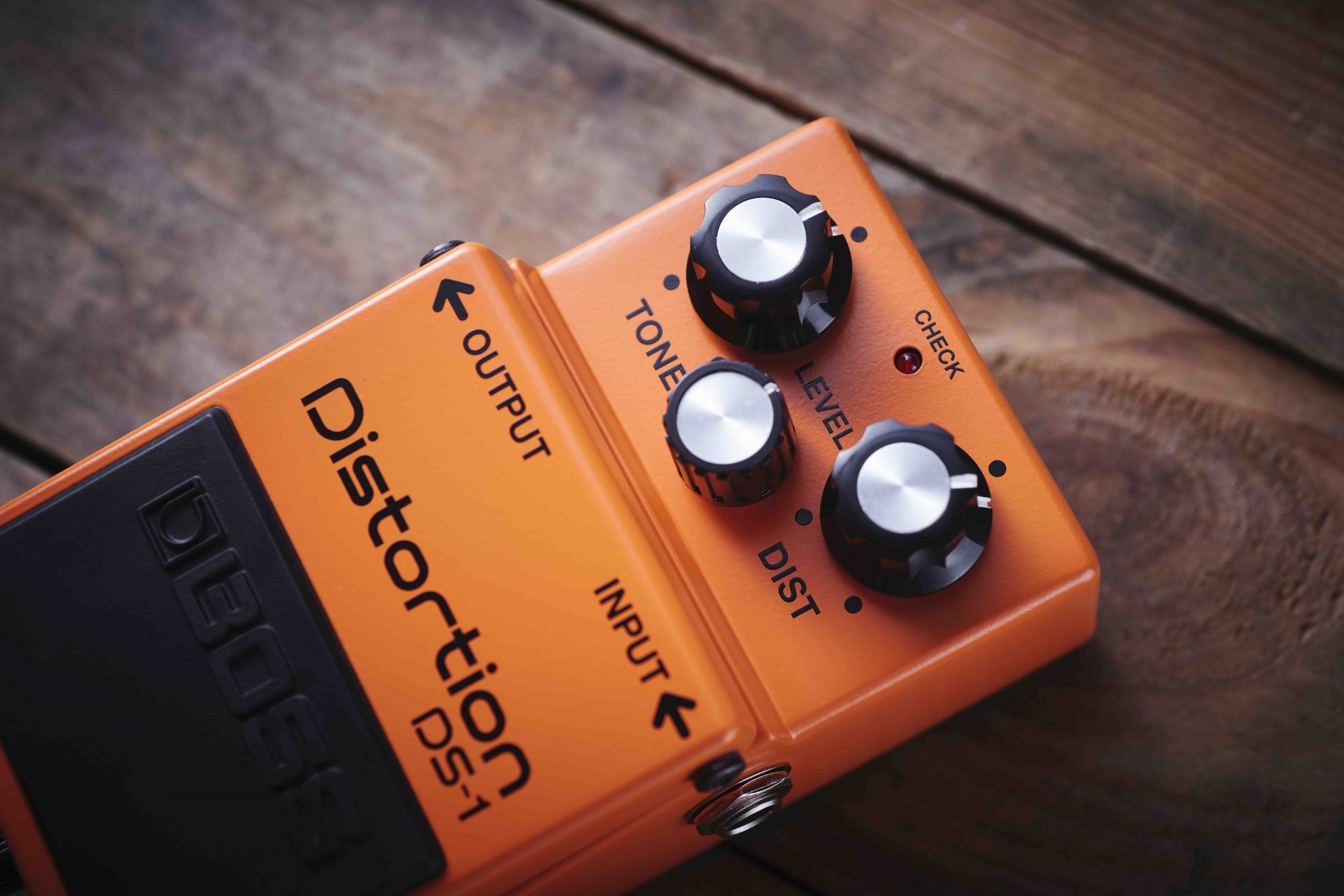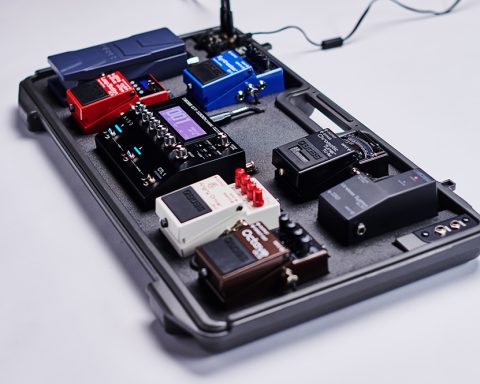In 1977, BOSS forever changed the guitar world with the debut of the first three models in the compact pedal series: the OD-1 Overdrive, PH-1 Phaser, and SP-1 Spectrum. The following year, the orange DS-1 Distortion joined the pioneering yellow, green, and red “traffic light” pedals and has remained in the lineup ever since. Armed with an innovative BOSS circuit design, the DS-1 redefined distortion by bringing tight, aggressive high-gain tones to the pedal world for the first time. Adopted by a who’s who of top players through the years, the DS-1 is the best-selling compact ever—with over 1.5 million sold to date—and it’s still a go-to favorite of today’s guitar generation.
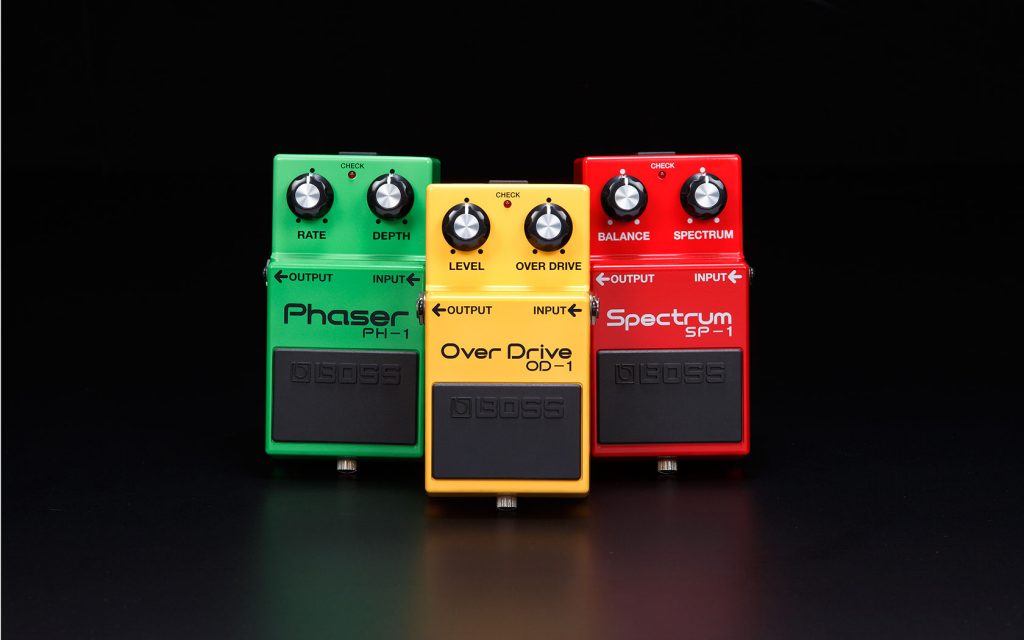

1978: A New Era in Distortion Begins
In the 1970s, the options in the stompbox world were nowhere near as diverse as they are today. Most drive pedals were in the fuzz category, each one dishing up different flavors of spitty filth that, while cool, were generally brash and unrefined. And when driven to high-gain settings, they produced harsh, buzzy tones and turned the guitar’s lower ranges to mud.
With the OD-1, BOSS introduced a new breed of distortion dubbed “overdrive,” which employed a unique asymmetrical clipping circuit to emulate the smooth breakup of a cranked-up tube amp—at sane volume levels. The OD-1 and its successor, the SD-1, were instant hits with guitarists everywhere, creating a whole new pedal category in the process.
For their next drive pedal, the BOSS engineers decided to take on full-throttle distortion and improve on the current designs in the marketplace. In creating the DS-1, they combined the era’s two most common types of drive circuits—transistor and op-amp—into a single hard-clipping design, peppered with some special sauce to increase clarity and reduce noise.
"In creating the DS-1, BOSS engineers combined the era's two most common types of drive circuits—transistor and op-amp—into a single hard-clipping design."
An Influential Design
The DS-1 is assertive and controlled at the same time, delivering sharp, hard-edged sounds loaded with rich harmonic overtones. The two-stage circuit at the heart of the pedal provides fullness and definition at every setting, from chunky drive for rhythms to angry, blistering distortion with singing sustain for solos.
Like the OD-1 before, the DS-1 circuit inspired a legion of pedal designers, and its wide-reaching influence can be heard in an endless range of distortion pedals through the decades. It’s also been a popular platform for pedal modders such as Analog Man, Robert Keeley, and many others.
Josh Scott from JHS Pedals is a big fan of the DS-1. “It literally is the distortion pedal,” Scott said in a History of Guitar Distortion video on his YouTube channel. “When you say distortion pedal, an orange box pops up into my head. It’s a cultural pop icon to me. There’s nothing more distortion than this box, so ’78 was a really good year. I think you’ve all owned this pedal. If you haven’t, you need to go pick it up, because it’s exceptional. It’s a go-to for some of the best rock recordings ever.”

“It literally is the distortion pedal. When you say distortion pedal, an orange box pops up into my head. It's a cultural pop icon to me." -Josh Scott (JHS Pedals)
Versatile Aggression
The keys to the DS-1’s enduring success are a simple interface and versatile character that can flow into all sorts of setups. A wide range of gain produces many different distortion colors, from mild to mean. And while all drive pedals generate some noise, the DS-1 is relatively quiet, even at high distortion settings.
Unlike typical tone controls that simply cut highs, the DS-1 features a “tilt” EQ that affects lows and highs with a single control. Turning the knob simultaneously boosts and cuts each end of the spectrum, providing just the right sound for any playing scenario.
The DS-1 works well with a variety of rigs. It’s great as a prime distortion for clean and mildly driven amps and works equally well with higher-gain amps. The DS-1 also plays well with other drive pedals, both as a boost-giver and boost-receiver.
Like all drive pedals, the amp you choose has a massive impact on the sound. Keep in mind that the DS-1 tone has a slight dip in the lower midrange, so you might get more favorable results with amps that have a prominent midrange presence, such as classic Marshall and Fender tweed models. If you’re using a mid-scooped amp like a blackface or silverface Fender, you might consider using the Normal input or turning off the bright switch if one is available. But experiment to find the sound that works. As with all things guitar—if it sounds and feels right, it is right.
"Unlike typical tone controls that simply cut highs, the DS-1 features a 'tilt' EQ that affects lows and highs with a single control."
Family Tree
Commemorative Models
In 1998, 20 years after the release of the DS-1, BOSS produced a very small number of unique DS-1 pedals to commemorate 6,000,000 worldwide sales of all compact series models. (As of 2022, this number has grown to over 17,000,000.) Created as gifts for BOSS distributors and top-performing dealers in North America and Europe, each came in a special display case and featured a shiny gold finish and special markings celebrating the milestone. These striking DS-1s are the rarest of BOSS pedals and gather large sums when they go up for sale.
To honor the 40th anniversary of the DS-1 in 2018, BOSS produced the DS-1-4A, a special version with a black body, gold-capped knobs, and a vintage silver screw for the battery compartment. The DS-1-4A was available for sale throughout the 2018 calendar year, so it’s currently not hard to find one on the used market if you want to grab one.
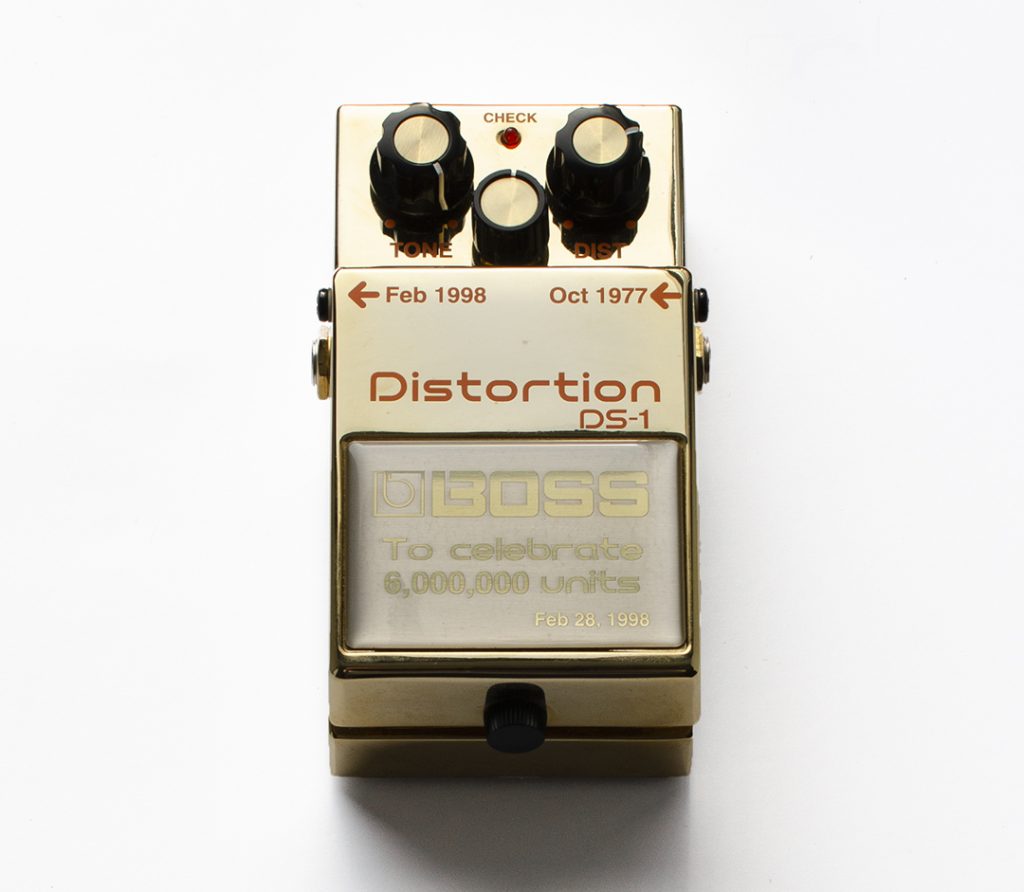
"To honor the 40th anniversary of the DS-1 in 2018, BOSS produced the DS-1-4A, a special version with a black body, gold-capped knobs, and a vintage silver screw for the battery compartment."
Blood Relatives
In 1987, BOSS introduced the dual-mode DS-2 Turbo Distortion, which remains in the lineup today. Turbo I mode produces a similar sound to the original DS-1, but with a slightly softer attack and flatter response. Turbo II kicks in an additional gain stage and a mid boost that’s perfect for lead playing.
2014 saw the release of the DS-1X Distortion, an advanced pedal powered by BOSS’s Multi-Dimensional Processing (MDP). This sophisticated tech analyzes the input signal in real time to bring new levels of dynamic response and clarity to the sound.
BOSS is also famous for multi-effects processors like the GT-1000, GT-1000CORE, ME-80, and many others through the years. All of these units come with a variety of different overdrive and distortion effects, with the DS-1 sound featured among them.

DS-1W Waza Craft Edition
In 2022, BOSS ushers its benchmark distortion into the premium Waza Craft family of pedals. Equipped with two versatile modes, the DS-1W features a newly revised analog circuit built with discrete components. Standard mode delivers the original DS-1 sound, while Custom mode offers a fatter sound with more midrange, a retuned tone control, and increased input sensitivity and output gain.
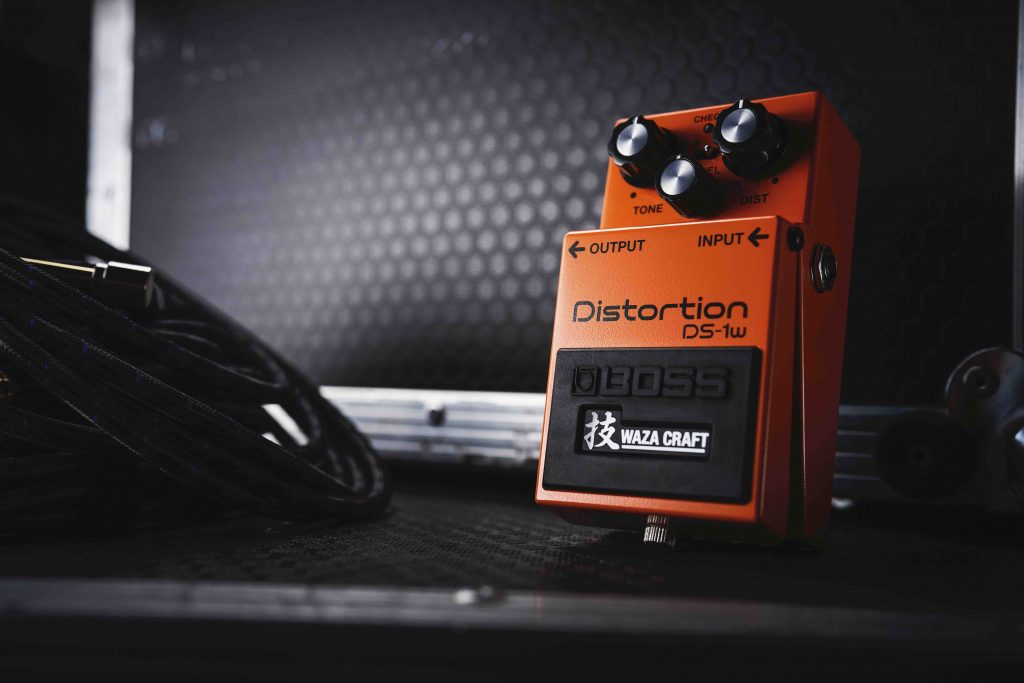
"Equipped with two versatile modes, the DS-1W features a newly revised analog circuit built with discrete components."
Noted Artists
Mike Stern
Venerated American jazz guitarist Mike Stern is a longtime BOSS pedal aficionado. Back in 2006, we interviewed him for BOSS Users Group. “I’ve been using BOSS pedals for about 15 years, maybe closer to 20 years, and I dig ’em a lot,” Stern said. “I’ve used the distortion, the DS-1, on every one of my own records, and on a lot of other peoples’ records too. I use it all the time. It just works for me, and it’s got a real nice sound to it, so I’ve been using it forever.”
Joe Satriani
Joe Satriani has a longstanding history of putting the orange BOSS stomp in front of his evolving amp preferences. As he detailed in a recent interview with the Music Gear Network YouTube channel, he started using the DS-1 live after the breakout success of his Surfing with the Alien album in the late ’80s.
“I’ve used the distortion, the DS-1, on every one of my own records and on a lot of other people's records too." -Mike Stern
“I wasn’t using distortion pedals for a long time. It wasn’t until this sort of surprise solo career suddenly materialized,” Satriani relates. “When Surfing with the Alien was released, I didn’t have a solo act. I’d never walked on stage and led an instrumental show. I had to go out on tour and figure out how to do it. And I thought, ‘Well, I’m not going to lug around vintage Marshalls.’ I didn’t have the money to do that. We were doing this really tiny tour, you know?”
Ultimately, the DS-1 was precisely the solution the teacher-turned-guitar hero needed. “I thought the only way to do this would be to get the sound in a little box, which was the DS-1, and figure out one amp that I could play to take a little bit of the buzz off and just add a bit more punch to the sound.”
"I swear the DS-1 beats 95 percent of everything that’s current or ever made. You can’t go wrong with it." -George Lynch

Steve Vai
Legendary guitarist Steve Vai is a longtime user of BOSS pedals and Roland gear, including the DS-1. The orange distortion was essential to his tone in his earlier years. He’s since moved on to a now-discontinued dual-distortion signature pedal, of which one side is influenced by the DS-1. However, as Thomas Nordegg, his longtime guitar tech, told BOSS Users Group, “From ’99 on up, yeah, he used the DS-1. That was his main pedal. Forever he had the DS-1, always.”
George Lynch
Influential shredder George Lynch of Dokken and solo fame is also a supporter of the DS-1. “The box I’ve used consistently since the ’80s is the DS-1,” Lynch told BOSS Users Group in 2004. “That pedal, for me, has always been my default overdrive/distortion pedal no matter what else I have access to, which is basically everything.” Lynch went on to qualify his opinion further by elaborating on his gear geek credentials. “I’m a pedal freak,” he explained. “I mean, I’m on eBay, I’m talking to collectors, I’m picking up every old retro pedal that Hendrix, Beck, or Page ever used. But I swear the DS-1 beats 95 percent of everything that’s current or ever made. You can’t go wrong with it.”
"I can tell you Kurt was using a BOSS DS-1, the orange pedal with three knobs. That was his sound in 1989." -Jack Endino on Kurt Cobain
Kurt Cobain (Nirvana)
As the ’90s kicked off with a bang, the DS-1 continued to play a part in movements like the nascent grunge era—before that term was even defined. Recalling the gear used for Nirvana’s debut LP, Bleach, Seattle super-producer Jack Endino told Guitar World, “It’s a ’67 Twin. In fact, I still have it; it’s called ‘The Bleach Twin’ because Kurt used it on Bleach. And I can tell you Kurt was using a BOSS DS-1, the orange pedal with three knobs. That was his sound in 1989.” Later, Kurt was also known to use the DS-2 Turbo Distortion, a close cousin of the DS-1.
John Frusciante (Red Hot Chili Peppers)
Red Hot Chili Peppers guitarist John Frusciante is closely associated with the DS-1 and DS-2. In a wide-ranging MusicRadar interview with the mercurial guitar god in 2006, both pedals are listed as key parts of his recording gear for the Stadium Arcadium album. A gear rundown video from Future Sound Music discusses John’s favored pedals through the years, which includes many other BOSS models in addition to the DS-1 and DS-2.
Mark Speer (Khruangbin)
Mark Speer of retro-futurists Khruangbin is a DS-1 devotee. “My preferred setup is my guitar into a Cry Baby wah that I never turn off. And then it goes from there into a BOSS DS-1,” Speer revealed to Premier Guitar in 2018. After detailing a few modern additions to his rig, the guitarist admitted, “I wish I could go back to the wah and DS-1, and that’s it.”
